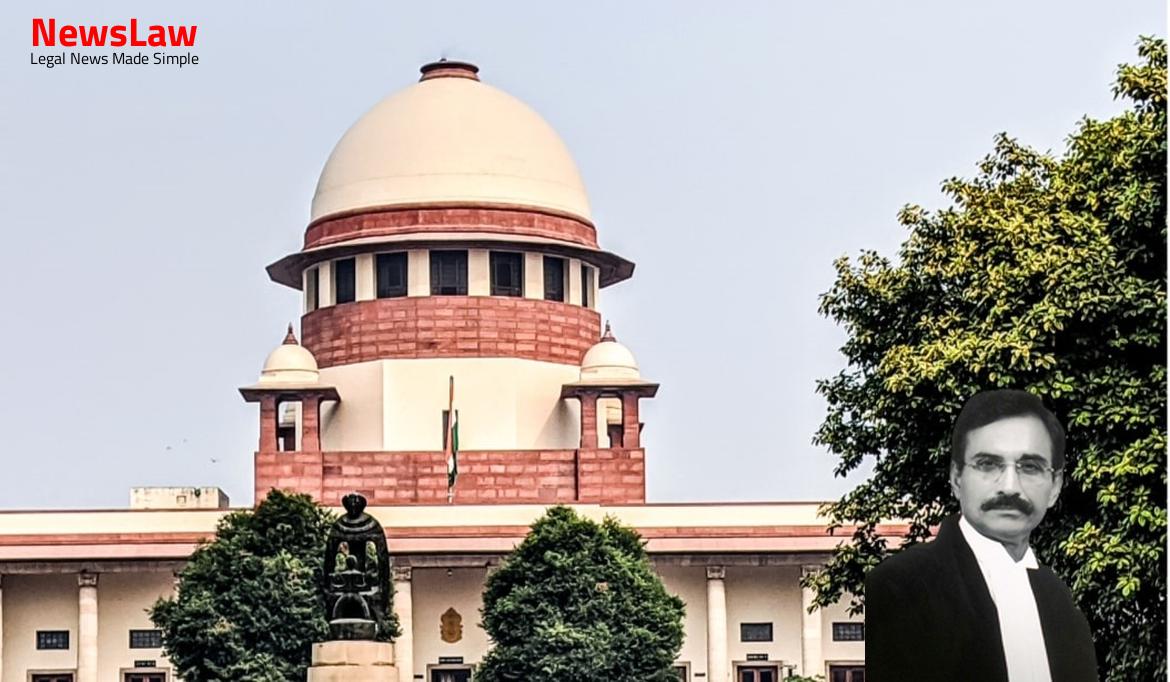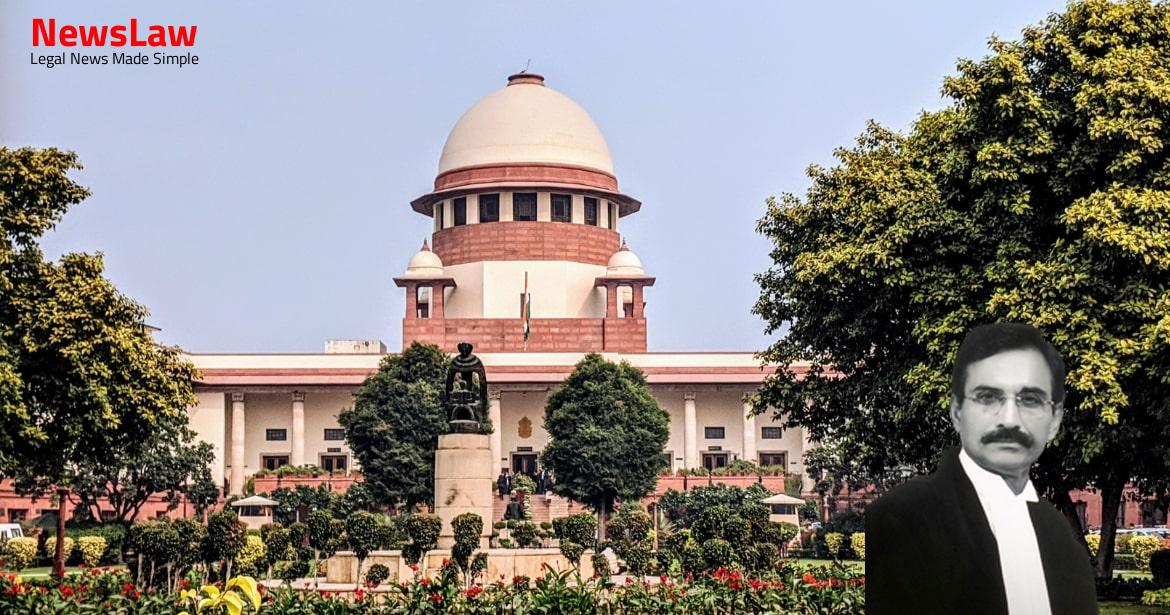Exploring a significant Supreme Court judgment on the application of the Rajasthan Escheats Regulation Act, 1956. The case delves into the validity of invoking the Act in relation to properties left by Sh. Raja Sardar Singh. Stay tuned to understand the legal intricacies involved in this landmark judgment.
Facts
- Sh. Raja Sardar Singh passed away in Mumbai on 28.01.1987 without legal heirs.
- He had executed a Will on 30.10.1985.
- The District Collector issued a letter instructing the collection of other properties owned by Sh. Raja Sardar Singh in different states or abroad.
- The Tehsildar took possession of the properties in Khetri based on the Spot Possession Report dated 31.07.1987.
- The District Collector directed the possession of unclaimed properties to be taken over by the State.
- The properties were attached by a proceeding dated 03.08.1987.
- Arjun Singh, claiming to be the agnate of the deceased, objected to the validity of the Will, alleging influence by a foreigner named Lady Olga Manning.
- The District Collector’s order dated 02.02.2016 rejected claims based on the Will and held that Sh. Raja Sardar Singh died intestate.
- The properties were to vest in the State Government of Rajasthan according to the Hindu Succession Act and Escheats Regulation Act.
- Various legal proceedings were initiated concerning the properties and ownership.
- The trustees appealed the judgement before the Delhi High Court.
- Sh. Raja Sardar Singh passed away on 28.01.1987 without any legal heirs.
- He left behind several valuable properties in different locations.
- The Delhi High Court was informed about the invocation of the Rajasthan Escheats Regulation Act in relation to Sh. Raja Sardar Singh’s properties.
- The High Court of Delhi dismissed the Testamentary Case No.26 of 1987 as the Will and Codicil were not proven to be executed in accordance with the law.
- The executors of the Will failed to dispel the suspicious circumstances surrounding the Will.
- The Delhi High Court directed that the State of Rajasthan should make a decision on the matter in accordance with law under the Rajasthan Escheats Regulation Act, 1956.
Also Read: High Court Acquittal Case of State of Uttar Pradesh v. Jai Prakash
Issue
- The appeal against the probate case is pending before the Division Bench of the High Court of Delhi.
- The appeal against the order passed by the District Collector is pending before the Board of Revenue.
- The High Court quashed three communications/orders dated 03.07.1987, 22.07.1987, and 03.08.1987 which initiated proceedings under the Rajasthan Escheats Regulation Act, 1956.
- Contention that it is not a case of bona vacantia (failure of legal heirs) and the invocation of proceedings under the Act is not sustainable.
- Argument that even if the Rajasthan Escheats Act is invoked, the provisions of the Act have not been strictly followed by the State Government, leading to vitiating the entire proceedings.
- Considering the first contention regarding the unwarranted invocation of proceedings under the Act as it was not a case of lawaris or abandoned property.
Also Read: Judgment Review: Supreme Court’s Ruling on the Capital Punishment Appeal
Arguments
- The Trustees filed an appeal against the dismissal of the Testamentary Case, while the agnates filed an appeal challenging the order of the Collector before the Board of Revenue.
- The High Court did not consider Sections 4 and 6 of the Escheats Act, which vests authorities with the power to initiate proceedings and take possession of escheat properties.
- The communications/orders dated 03.07.1987, 22.07.1987, and 03.08.1987 were in accordance with the provisions of the Escheats Act.
- Citing Bombay Dyeing’s case as a precedent, it was argued that the mere absence of a claim for a certain period does not make the property abandoned.
- The appellant-State of Rajasthan initiated proceedings under the Escheats Act due to the absence of a rightful owner for the properties.
- The contention was raised that the Act applies only to properties vesting in the State as abandoned property.
- It was argued that escheating does not arise if there is a claim on the property and it must be established as abandoned property for the government to claim escheat.
- The respondents contended that the Khetri Trust was in possession of the property and the possession was taken over by the Tehsildar under Section 4 of the 1956 Act.
- The respondents’ counsel argued that the properties of Sh. Raja Sardar Singh cannot be considered abandoned as there were known agnates and cognates.
- To escheat properties, a total absence of claimants for a reasonable period (seven years) and conclusive establishment of the property as abandoned is necessary.
- The Senior counsel argued that the properties of the deceased were in possession of the Trust which was disturbed by the State taking over the possession.
- The Spot Inspection Report confirmed that the property Khetri House was sealed with the seal of Khetri Trust and no one was found in physical possession during the inspection.
- Key questions for determination include whether the Trust was in ‘present possession’ based on the seal affixed, the capacity in which Nirbhay Singh was summoned, and the compliance of the District Collector’s order with the Rajasthan Escheats Act, 1956.
- It was contended that the possession was taken from the Trust in contravention of the proviso to Section 4(1) of the Escheats Act which protects current possession from being disturbed.
- Reference was made to legal precedents like *Bombay Dyeing and Manufacturing Co., Ltd. v. State of Bombay* concerning the exercise of power under Article 296 when there are claimants and the burden of proof regarding property being ‘bona vacantia’.
- Underlying argument is that the State’s takeover from the Trust, assumed to be in ‘present and actual possession’, is illegal and violates the Escheats Act.
- The High Court’s decision regarding the maintainability of proceedings under the Rajasthan Escheats Regulation Act, 1956, and the quashing of communications/orders were questioned based on subsequent orders and actions by the competent authorities.
Also Read: Synergy and Solution Incorporation v. Vipin Dhopte – Landmark Judgement by Supreme Court of India
Analysis
- Escheat is a principle where property of a person dying intestate and without any qualified heir devolves to the Government.
- Section 29 of the Hindu Succession Act, 1956 deals with the principle of escheat.
- Section 29 comes into play only when there is a complete absence of any qualified heir.
- The Act aims to determine the rightful owner, secure the property, adjudicate on conflicting claims, and finally pass orders of vesting after detailed enquiry.
- Section 4 of the Act outlines the duties of the Tehsildar in identifying and taking over such properties.
- The doctrine of escheat recognizes the State as the paramount sovereign in cases of failure of heirs.
- Alternative remedy will not be a bar in cases of fundamental rights enforcement, violation of fundamental rights or natural justice, and jurisdictional challenges.
- The High Court has the discretion to entertain a writ petition despite the availability of an alternative remedy.
- The High Court should consider subsequent events and pending appeals before interfering with communications/orders issued in the past.
- The absence of any heir is a precondition for escheating property to the Government.
- The State takes the property subject to all obligations and liabilities in cases of escheat.
- The Civil Court has the jurisdiction to adjudicate on civil disputes unless barred by statute.
- The collector can only exercise powers specifically conferred upon him and normally escheat is frowned upon unless fully satisfied conditions.
- The State takes property upon a clear and established failure of heirs based on the doctrine of escheat.
- The property is escheated when an intestate has no qualified heir, and the State takes it subject to all obligations.
- The State does not take the property as a rival or preferential heir but as the lord paramount of the country’s soil.
- The burden of proof lies on the party asserting the absence of a qualified heir for escheat.
- The law does not readily accept escheat claims without clear evidence of a total absence of heirs.
- Escheat to the State occurs only when no qualified heir is present.
- The Escheats Act, 1956 provisions were followed properly with inquiry about legal heirs of Sh. Raja Sardar Singh before initiation of proceedings.
- All claimants, except for Nirbhay Singh acting as Manager of Khetri Trust, withdrew objections in the probate proceedings.
- Trustees of Khetri Trust were impleaded in the proceedings per court order.
- The Trust claimed properties via the Will, but the Trustees changed over time.
- Aganates’ objections in probate proceedings were withdrawn; no legal heirs established status in court.
- State of Rajasthan treated the property as ‘bona vacantia’ in compliance with the Escheats Act, 1956.
- Detailed procedures under the Escheats Act were followed before initiation of proceedings.
- The High Court’s quashing of certain orders was not upheld, emphasizing compliance with the Escheats Act.
Decision
- The impugned order of the High Court in Writ Petition No. 2713 of 1987 is set aside.
- The appeal is allowed.
- The judgment and conclusion of the Board of Revenue are subject to the decision of the Delhi High Court in the Testamentary Appeal pending before it.
- Parties will bear their respective costs.
Case Title: THE STATE OF RAJASTHAN AND ORS. Vs. LORD NORTHBOOK AND ORS.
Case Number: C.A. No.-006677-006677 / 2019



